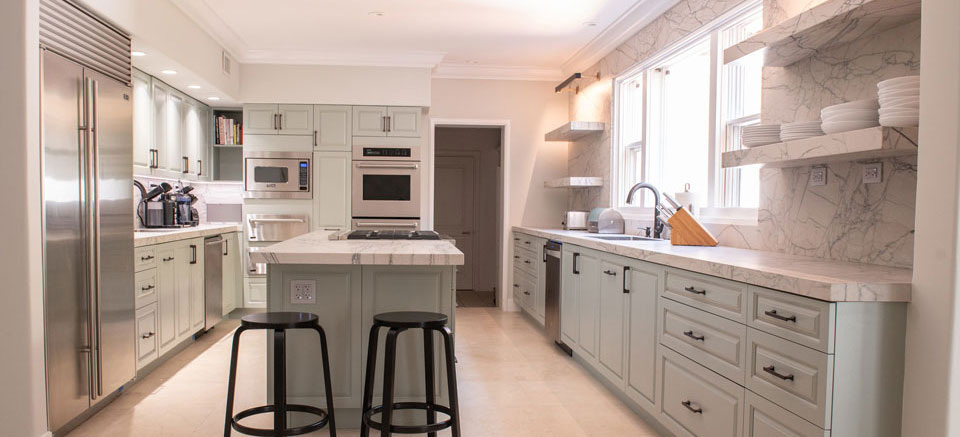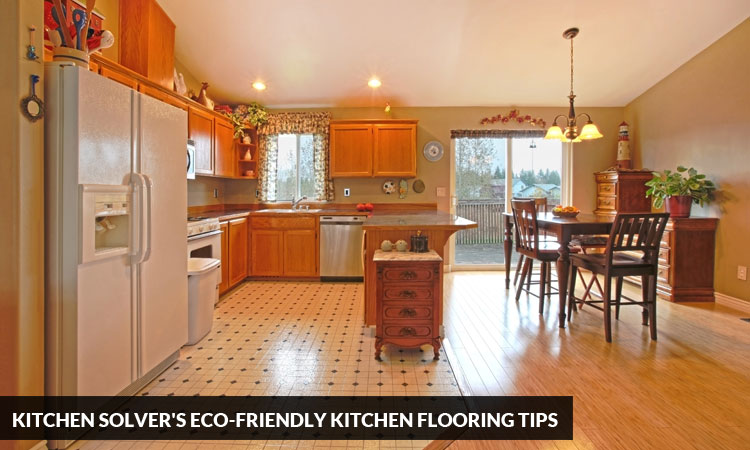Kitchen Solver’s Eco-Friendly Kitchen Flooring Options
Kitchen flooring must have great durability and moisture resistance, but there are plenty of green options that meet these demanding criteria. In today’s post, the Kitchen Solver’s team shares 4 eco-friendly flooring options that look and perform great!
Protect our forests with cork flooring
Cork isn’t what springs to mind for most people when the subject of kitchen flooring is brought up, but it’s really a wonder-material.
Since cork is made from bark, sourcing cork flooring does not require cutting down a tree. Instead, suppliers strip down their trees every few years, then wait for the “reserve” to naturally replenish itself. The stripping process is environmentally friendly, so much so that the World Wildlife Federation gives it a stamp of approval. In fact, buying cork helps protect existing oak forests (and the ecosystems they support) that would otherwise be targeted for clear cutting to accommodate growing cities.
Cork is a fantastic flooring option that is as safe as it is low-maintenance. It’s naturally antimicrobial, hypoallergenic, fire-retardant, and highly resistant to mildew and mold.
Cork is also great for a functional perspective. Soft, warm, and low-impact, it’s the perfect surface to be standing and working on for long periods while you prepare food or scrub down the dishes. Your back and knees will thank you – and so will the environment!
All-natural, all-recycled modern linoleum
Linoleum was largely replaced with vinyl sheeting in the mid-20th century, which is chalk full of VOCs (volatile organic compounds). However, the “real McCoy” is surprisingly “green.”
This eco-friendly flooring recommendation might come as a shock, but linoleum is made from natural materials, including linseed oil, tree resins, ground limestone, wood flour, cork dust and pigments, to name a few. These components are combined and pressed onto a jute backing, which can be sourced entirely from recycled materials.
Along with being naturally antimicrobial, modern linoleum is relatively cheap to install, and can be purchased in a wide array of flooring styles, including tiles, planks, and sheets. Best of all, linoleum lasts a long time, which cuts down on financial costs and environmental stresses associated with repairs or replacements.
Go green with glass
Glass has been beautifying homes for centuries, and it’s been a staple material for our kitchen remodeling business since the early 1980s. Not only does it provide a compelling visual depth and shine, but its reflective qualities can optimize the natural lighting in your kitchen space.
From a functional perspective, glass is great: it doesn’t stain, wipes clean, and makes life tough for mold and mildew. The only thing to watch for is glass’s slippery qualities, so consider installing slip-proof mats in areas where cleaning, filling pots, or doing dishes commonly occur.
Best of all, you can buy glass tiles made from 100% recycled materials. If you can find something sintered, even better – this manufacturing alternative to conventional melting saves serious energy.
Get trendy with reclaimed wood
Reclaimed, salvaged, and engineered wood is the latest kitchen design craze. Using reclaimed wood recycles raw materials, which means you can enjoy a stylish aesthetic without worrying about contributing to our planet’s deforestation issues. Get in touch with local excavators and contractors to see what you can scavenge, or ask a Kitchen Solver’s consultant about some eco-friendly wood flooring options.
You can browse more eco-friendly flooring options and remodeling practices at https://www.kitchensolvers.com.
Back




